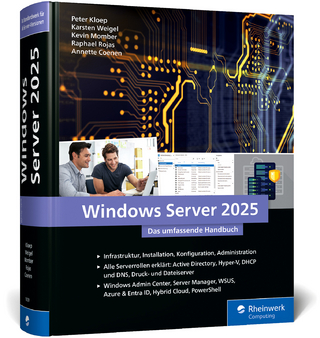
Windows 98 User Manual
Que Corporation,U.S. (Verlag)
978-0-7897-1657-6 (ISBN)
- Titel ist leider vergriffen;
keine Neuauflage - Artikel merken
PLEASE PROVIDE
Get the manual that you should have gotten when you purchased Windows 98! Clear, to-the-point reference title takes you through Windows in an easily understandable way. Learn how to use each of the Windows 98 applications with complete coverage of all user oriented features. - Expert instructors have assembled a manual that makes sense for normal Windows 98 users. - Clear end-user focus only covers those Windows 98 features of interest to end users. - Windows 98 User Manual doesn't try to cover the vast amount of complex, detailed information that is only of interest to system administrators. - Nearly pure reference title quickly shows you what each relevant part of Windows 98 is, what it does, and how to use it successfully This truly is the manual you should have gotten when you purchased Windows 98.
I. THE WINDOWS INTERFACE.
1. 15-Minute Guide to Using Windows.
Starting Your Computer. Basic Mouse Skills. Using the Start Menu. Identifying Windows Objects. Working with Windows. Installing a Program. A Look at Web View. Shutting Off Your Computer.
2. The Windows Desktop.
Icons and Shortcuts. The Start Menu. The Taskbar. The Recycle Bin.
3. Navigating Windows.
Using the Mouse and Pointer. Working with a Window. Using Web View.
4. My Computer and Network Neighborhood.
My Computer. Network Neighborhood.
5. Working with Windows Programs.
Menus. Dialog Boxes. Property Sheets. Window Elements. Using More than One Program. Starting Programs Automatically. Installing and Uninstalling Programs.
6. The Windows Help Utility.
Working with Help. Putting a Bookmark on a Help Page. Adding Your Own Notes to Help Topics.
7. Exploring Your Computer.
Understanding Disks, Folders, and Files. Using Windows Explorer. Setting Folder Options.
8. Working with Files and Folders.
Copying and Moving Files. Renaming and Deleting Files. Creating New Folders. Copying and Moving Folders. Renaming and Deleting Folders. Recovering Deleted Files and Folders. Changing the Name of a Disk. Using Floppy Disks. Sharing Your Files and Folders.
II. THE CONTROL PANEL.
9. The Control Panel: Basic.
Date/Time. Desktop Themes. Display. Using Multiple Displays. Fonts. Game Controllers. Keyboard. Mouse.
10. The Control Panel: Intermediate.
Accessibility Options. Add New Hardware. Add/Remove Programs. Modems. Multimedia. Printers. Sounds.
11. The Control Panel: Advanced.
Internet. Mail and Fax. Network. Passwords. PC Card (PCMCIA). Power Management. Regional Settings. System. Telephony. Users.
III. PUTTING WINDOWS TO WORK.
12. The Printers Folder.
What is the Printers Folder? Setting Up a Local Printer. Using a Network Printer. Viewing and Managing a Printer's Queue. Shortcuts to Printing. Setting Printer Options. Sharing Your Printer.
13. The Fonts Folder.
What Are Fonts? Viewing and Managing Fonts. Installing and Removing Fonts. Using Special Characters. Controlling Fonts for Printing.
14. The Windows Accessory Programs.
Notepad. WordPad. Calculator. Character Map. Phone Dialer.
15. More Windows Accessory Programs.
Multimedia. System Tools. Clipboard Viewer. Games.
16. Sharing Data Between Documents and Programs.
Why Share Data? What Is the Clipboard? Copy, Cut, and Paste. Linking Data. Understanding and Using OLE.
17. The Briefcase.
What is the Briefcase? Creating a Briefcase.
IV. COMMUNICATION AND THE INTERNET.
18. Using a Modem.
What is a Modem? Installing a Modem. Making the Modem Work. Adding a New Modem. Modem Diagnostics.
19. Using Dial-Up Networking.
Installing Dial-Up Networking. Creating and Using a Connection. Using Dial-Up Networking. Virtual Private Networking. Dial-Up Server
20. Setting Up and Using Internet Explorer.
Installing Internet Explorer. Configuring Internet Explorer. Browsing the Web with Internet Explorer.
21. Putting Internet Content on the Desktop.
Overview of the Active Desktop. Using Web Content as Wallpaper. Using the Channel Bar.
22. Using Outlook Express for Email and Newsgroups.
Installing Outlook Express. Creating and Sending Messages. Reading and Replying to Messages. Advanced Features. Internet News Using Outlook Express. Viewing Newsgroups. Posting Messages: Some Basic Usenet Rules. Posting a New Message. Viewing and Decoding Attachments.
23. Using HyperTerminal.
What is HyperTerminal? Installing HyperTerminal. Setting Up a Connection. Calling Another Computer. Configuring the HyperTerminal Display. Downloading and Uploading Files.
24. Using Chat, NetMeeting, and NetShow Player.
Configuring and Using Chat. Configuring and Using NetMeeting. Configuring and Using NetShow Player.
25. Home and Small Business Networking.
Understanding Direct Cable Connection. Peer-to-Peer Networking. How Peer-to-Peer Networks Work. Planning Your Network. Wiring Your Network. Network Adapter Card. Network Operating System. Network Transport Protocols. Configuring Peer Resources. Sharing Resources Between Computers. Security. Using Personal Web Server (PWS).
V. MANAGING YOUR COMPUTER.
26. Adding New Hardware.
What is Hardware? Understanding Plug and Play and Legacy Devices. Installing a New Device. Letting Windows Know It's There. Viewing Your Hardware Settings.
27. Managing Your Hard Disks.
Getting More Free Space. Using Disk Compression. Automating Compression with the Compression Agent. Making the Disk Work Better. Checking the Disk for Problems.
28. Changing Windows' Appearance.
What Can You Change? Changing the Desktop. Changing the Taskbar.
29. Backing Up Your Files.
What is a Backup, and Why Do It? Different Ways to Back Up Your Files. Introducing Microsoft Backup. Installing the Backup Program. Using the Backup Program.
VI. USING MULTIMEDIA.
30. Working with Graphics and Video.
Working with Images. Playing Video Clips. Using TV in Windows.
APPENDICES.
Appendix A. Installing and Upgrading Windows.
Upgrading Your Installation. Installing on a Formatted Drive. Installing on a Blank Drive.
Appendix B. The MS-DOS Prompt.
Running a DOS Session in Windows. Running DOS Programs in Windows. DOS Application Settings. Booting to DOS.
Index.
| Erscheint lt. Verlag | 15.10.1998 |
|---|---|
| Sprache | englisch |
| Maße | 233 x 187 mm |
| Gewicht | 889 g |
| Themenwelt | Informatik ► Betriebssysteme / Server ► Windows |
| ISBN-10 | 0-7897-1657-7 / 0789716577 |
| ISBN-13 | 978-0-7897-1657-6 / 9780789716576 |
| Zustand | Neuware |
| Informationen gemäß Produktsicherheitsverordnung (GPSR) | |
| Haben Sie eine Frage zum Produkt? |
aus dem Bereich


